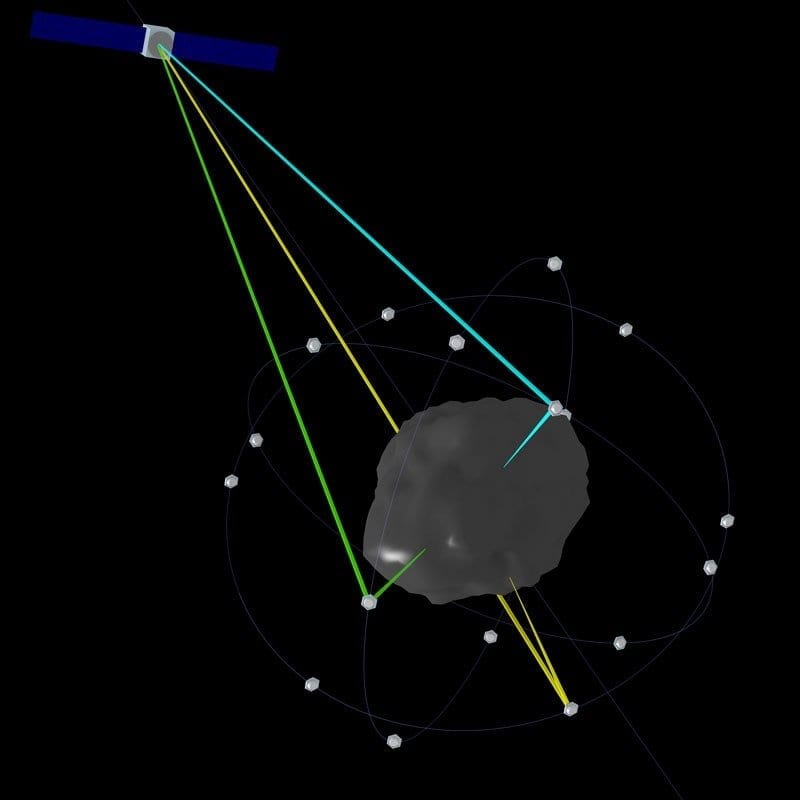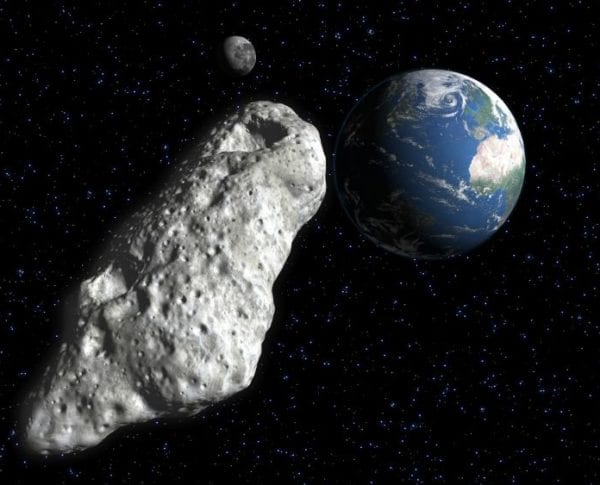
A space-based laser system proposed to NASA by University of Alabama in Huntsville (UAH) researchers could be a cost-effective way to nudge small asteroids away from a collision course with Earth.
With the February meteor explosion in Russia heightening U.S. government interest in how asteroid collisions with Earth can be prevented, the UAH scientists say using their system against smaller asteroids will provide practical scientific data needed to scale it up to defend against very large asteroids.
The bus-sized meteor that exploded at Chelyabinsk, Russia, is a small object in comparison to others in space. It still left a plume of dust with hundreds of tons of material in it in Earth’s atmosphere for three months.
The system the UAH scientists propose could move a meteor of that size away, said Dr. Richard Fork, an electrical and computer engineering professor at UAH who is the principal investigator for the Laser Science and Engineering Laboratory. A recent paper on their method is “Mode-locked Lasers Applied to Deflecting a Near Earth Object on Collision Course with Earth”; Richard Fork, Spencer Cole, Luke Burgess, Grant Bergstue; arXiv:1309.3238 (physics.space-ph).
Our concept is to go out after the little guys and then as we learn more, we can take on the big guys,” said Dr. Fork. “As far as we’re concerned, we have identified a technically calculable and optimally efficient means of deflecting small asteroids of the Chelyabinsk class. This method can be explored, quantitatively tested and verified in the very near future and then scaled to address larger asteroids and, possibly, eventually even comets.”
SMALL SPACECRAFT
The UAH system could be delivered to space to meet a detected threatening object on relatively short notice using a system requiring one “mother” spacecraft relatively near the asteroid and a configuration of multiple microspacecraft more closely orbiting the asteroid. “The amount of average power to be delivered to the asteroid as coherent laser light can be comparable to the power, 10 kilowatts, supplied by the solar system to the currently existing Dawn spacecraft,” Dr. Fork said. “We see one of the most demanding technical tasks as developing the optimally efficient mode-locked laser and optical system required to apply the deflecting force.”
The laser-equipped spacecraft orbiting within a few kilometers of the asteroid would send trains of ultrashort optical pulses to the reflecting optical systems on the micro-spacecraft directly orbiting the asteroid. The optical systems on the microspacecraft are designed in turn to redirect and focus specifically designed trains of ultra-short duration optical pulses simultaneously on multiple locations on the asteroid.
A computer based system managing the deflection process includes a capability to locate small areas on the asteroid that are locally flat, optimally located and which also have surface normals oriented for efficient generation of the net deflecting thrust. The ultra-short pulses from the lasers will superheat the asteroid in the illuminated spots. That causes discharge of plumes of ejecta that will push the asteroid in a direction opposite to that of the ejected material.
“We propose to focus multiple pulses simultaneously on at least three specifically chosen small areas for each impulsive event, each of about 1 millimeter diameter,” Dr. Fork said. “We propose to use a carefully balanced thrust delivered so as to push the asteroid in an optimally efficient manner. We can both choose where the asteroid will go and also verify, after an adequate number of such events have occurred, that the desired deflection is being successfully achieved. The pulses each have a very brief duration, but we achieve the required net deflection by transmitting many such sets of pulses per unit time and then using our observations to continuously improve the deflection process.”
The black cloud of ejecta created by the laser impulses becomes clear within roughly 3 microseconds, allowing for the next short burst.
READILY AVAILABLE
Components for such a system are already in use or can be engineered within a reasonable time period. “Much of the required technology is existing stuff that is out there now. It’s not too expensive,” Dr. Fork said, adding that the concept is an evolution of work he has been involved in since he was at Bell Laboratories in the 1980s. “It’s doable in a few years if the effort is well-funded.”
UAH graduate student Luke Burgess has developed an algorithm needed for optimally positioning the microspacecraft that orbit the asteroid and deliver the deflecting impulses.
“As a research university, we are going about it in great detail,” said Dr. Fork, noting that his team includes both physicists and engineers and that he also is probing the problem with about 50 students in a laser systems class and also in a special topics class called Cooperative Quantum Energy. “We waited to announce this in the media until we had a reasonably well-developed technical story to tell. We believe that if you do the engineering right, this can be accomplished relatively simply and at reasonable cost.”
The power needed to shift the path of a small asteroid appears achievable from an engineering standpoint in the relatively near future, Dr. Fork said.
The Latest Bing News on:
Asteroid defense system
- Asteroid hunters spot more than 27,000 'hidden' space rocks - and some pass 'dangerously' close to Earthon April 30, 2024 at 5:00 pm
Their collaboration hopes to speed up the development of 'a comprehensive map of the solar system' needed for 'planetary defense,' according to one Harvard astrophysicist, Matthew Holman, who helped ...
- Asteroid hunters spot 27,500 'hidden' space rocks, some close to Earthon April 30, 2024 at 4:55 pm
Their collaboration hopes to speed up the development of 'a comprehensive map of the solar system' needed for 'planetary defense,' according to one Harvard astrophysicist, Matthew Holman, who helped ...
- Killer Asteroid Hunters Spot 27,500 Overlooked Space Rockson April 30, 2024 at 11:02 am
With the help of Google Cloud, scientists churned through hundreds of thousands of images of the night sky to reveal that the solar system is filled with unseen objects.
- Asteroid hunters spot 27,500 overlooked near-Earth asteroids — more than were discovered by all of the world’s telescopes last yearon April 30, 2024 at 9:53 am
Asteroid hunters have identified 27,500 overlooked near-Earth asteroids using cutting-edge tech that could potentially stave off armageddon in the future.
- This spacecraft is headed to NASA's asteroid-crash aftermath — but first, it'll stop by Marson April 30, 2024 at 9:00 am
After Hera speeds past Mars, it's onward to Didymos and its now -misshapen companion Dimorphos (thanks to the collision), where the spacecraft will gather information on the asteroid to better ...
- Asteroid Ryugu holds clues about bombardment in the early solar systemon April 30, 2024 at 8:00 am
A recent study examined the effects of space weathering on Ryugu, an asteroid explored by the Hayabusa2 spacecraft.
- Hera asteroid mission's side-trip to Marson April 25, 2024 at 10:42 am
ESA's Hera asteroid mission for planetary defense will make a swingby of Mars next March, borrowing speed to help reach its target Didymos binary asteroid system.
- NASA says 280-foot asteroid set to approach Earth! Know how close it will geton April 20, 2024 at 9:48 am
And now, US space agency NASA says that one asteroid that is as big as 280 feet is all set to get very close to Earth tomorrow, April 21. This makes it as big as a building. Just imagine what will ...
- European Space Agency set to launch probes at asteroid to test planetary defense systemon April 18, 2024 at 10:54 am
The Hera mission will study the Dimorphos asteroid that was pushed off course by NASA’s DART spacecraft in 2022 ...
- Can we stop an asteroid from hitting Earth?on April 15, 2024 at 2:00 am
Kate The Chemist speaks with Nancy Chabot, one of the leaders behind NASA’s planetary defense ... in our Solar System. She was the Coordination Lead on NASA's Double Asteroid Redirection Test ...
The Latest Google Headlines on:
Asteroid defense system
[google_news title=”” keyword=”Asteroid defense system” num_posts=”10″ blurb_length=”0″ show_thumb=”left”]
The Latest Bing News on:
Asteroid deflection
- This spacecraft is headed to NASA's asteroid-crash aftermath — but first, it'll stop by Marson April 30, 2024 at 9:00 am
After Hera speeds past Mars, it's onward to Didymos and its now -misshapen companion Dimorphos (thanks to the collision), where the spacecraft will gather information on the asteroid to better ...
- NASA has a scary protocol in place if an asteroid was going to hit Earthon April 29, 2024 at 9:34 am
DART smashed into the asteroid of choice, called Dimorphos, which was a minor-planet moon of the asteroid called Didymos. Dimorphos posed zero threat to Earth during the experiment, with it being ...
- How Scientists Are Preparing for Apophis's Unnervingly Close Brush With Earthon April 24, 2024 at 5:00 pm
We may earn a commission from links on this page. This is radar image of a near-Earth asteroid similar to Apophis. We actually know very little about what Apophis looks like, but its pending flyby ...
- Earth's weird 'quasi-moon' Kamo'oalewa is a fragment blasted out of big moon crateron April 23, 2024 at 1:00 pm
Scientists turned into cosmic crime scene investigators to reconstruct the impact that sent Earth's "quasi-moon" Kamo'oalewa rocketing from the lunar surface millions of years ago.
- Minerals are in short supply on Earth. This startup wants to mine asteroidson April 23, 2024 at 1:13 am
Now the California-based startup is attempting to make asteroid mining a reality. The company isn’t alone. The clean energy transition is expected to cause demand for mineral resources to ...
- Debris From NASA Asteroid Collision May Hit Marson April 9, 2024 at 10:28 am
A NASA experiment that sent a spacecraft slamming into the side of an asteroid may have sent debris flying into space, possibly into the path of Mars. The asteroid, named Dimorphos, was hit by ...
- NASA's 'Armageddon' mission backfires! DART asteroid deflection test created a cloud of giant boulders that are set to crash into Marson April 4, 2024 at 1:32 pm
All the observations taken so far prove that DART has been a successful test for asteroid deflection since it managed to change the orbital period of Dimorphos and it did not create any other ...
- NASA Crashed a Spacecraft Into an Asteroid and There Could Be Some Consequenceson April 4, 2024 at 6:30 am
In September of 2022, NASA’s DART mission smashed into the astroid Dimorphos at 14,000 miles per hour to test the effects of asteroid deflection. Although the mission was a success, scientists ...
- Nasa's Dart mission to blast asteroid off course created debris that will smash craters into Marson April 4, 2024 at 3:10 am
"All the observations taken so far prove that Dart has been a successful test for asteroid deflection since it managed to change the orbital period of Dimorphos and it did not create any boulder that ...
- Gravitas | The impact of NASA asteroid deflectionon April 2, 2024 at 4:59 pm
NASA achieved a resounding success last year when it intentionally crashed a spacecraft into an asteroid. The test was a way to deflect potentially hazardous space rocks from hitting Earth.
The Latest Google Headlines on:
Asteroid deflection
[google_news title=”” keyword=”asteroid deflection” num_posts=”10″ blurb_length=”0″ show_thumb=”left”]










